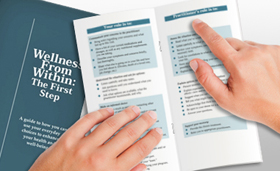Search Results
Healthy Eating on a Budget!

Judy E. Buss
There is a growing public realization that a wholesome diet plays a major role in good health and disease prevention. Unfortunately, some believe that healthy eating is expensive and that they are unable to afford it. The good news is, for a number of reasons, this belief is a myth! Eating nutritious fare is actually cheaper than eating out or consuming highly processed food at home.
When living under circumstances where you have no say over grocery shopping and meal preparation, or when dining out, healthier choices can still be made and portion size controlled. Contrary to popular belief, even fast food restaurant meals are not cheaper than eating at home; upon a closer look, you’ll discover that preparing food at home can be infinitely healthier and less expensive. Folks who say they don’t have time to cook, even quick and easy recipes, should then make time to be sick, miserable, and spend more time and dough on health care.
Let’s compare, breakfast options. For example, a McFastFood breakfast of oatmeal with fruit and maple flavoring costs $2.10. Add to that a $1.50 soft drink, or $1.00 coffee, or a $2.70 never-seen-a-cow milkshake. This breakfast, which died of unnatural causes and is loaded with sugar and unhealthy additives, costs 3 – 4 dollars.
In contrast, consider a bowl of freshly home-cooked Old Fashioned rolled oats (oatmeal) at 8 cents per serving, with a small pat of butter (5 cents), a sprinkle of cinnamon, 1 cup of 2% milk (24 cents), plus an apple (44 cents), a hard-cooked egg (17 cents), or a cup of fat-free yogurt (47 cents). This quality, nourishing, home-prepared breakfast costs about $1.30. Many equally nutritious and inexpensive breakfast choices abound. Other meals, even ones including reasonable (not excessive) portions of chicken, turkey, or fish, cost only a few dollars.
Having a meatless day or two per week can also do wonders for your health and pocketbook. Dining at Full Service, Casual Dining, Buffet restaurants and the like, costs a great deal more than a home- prepared, wholesome meal. The cuisine in those establishments is also mostly unhealthy (drowning in butter, cheese, cream, and sugar).
In addition, highly processed food (a.k.a empty calories), such as white bread, white pasta, white rice, sugary beverages and foods, precooked frozen dinners, and canned vegetables, go right through you; your body has little work to do to digest them, since these foods contain only a fraction of their original level of nutrition . Eating these types of foods (also at home), leaves you constantly hungry, which results in frequent eating, higher food expense, weight gain, and poor health.
Health-minded folks drink mainly (filtered) water, knowing that the body is made of about 70% water (not soda), and needs constant replenishing. By investing a few dollars in a countertop water-filtering pitcher and cartridge (which is available also in discount stores), you can effortlessly filter all your drinking and cooking water and save a bundle! The cartridge in the pitcher needs to be changed only once every few months. You are also better off making your own additive-free tea for pennies. This can be easily accomplished while you are already in the kitchen cooking a meal.
Smart shopping, eating out less, and smart home cooking strategies boost your wellness, quality of life, and save you large amounts of money; it allows you to buy wholesome ingredients you thought you can’t afford. Purchase your whole foods at discount grocery stores, produce stands, and farmers markets, and buy on sale only nutritious food items you need and use! Shop mindfully and deliberately, and do so solo, without company that may pressure or entice you to buy what you don’t need and is not on your shopping list. (Yes, a list helps you stay on track). Planning for and shopping only once per week saves a great deal of time and money as well.
Fruit and vegetables in season cost less. Some produce is reasonable all year round, such as cabbage, green beans, Romaine lettuce, sweet potatoes, and bananas. A limited amount of frozen (raw) veggies – that you briefly cook at home – can be part of a healthy diet. Olive oil, garlic, onions, herbs, spices, citrus zest, and juices transform whole grain, bean, and numerous other dishes into scrumptious culinary events.
So abandon the daily non-recommended Standard American Diet (SAD); slash your food bills and enjoy health-promoting goodness with every bite!
“Mission Nutrition” Tips and Recipes from Judy E. Buss, Syndicated Eating-for-Health Columnist
Stay tuned for more Judy E. Buss’ “Mission Nutrition” words of wisdom and recipes.




















